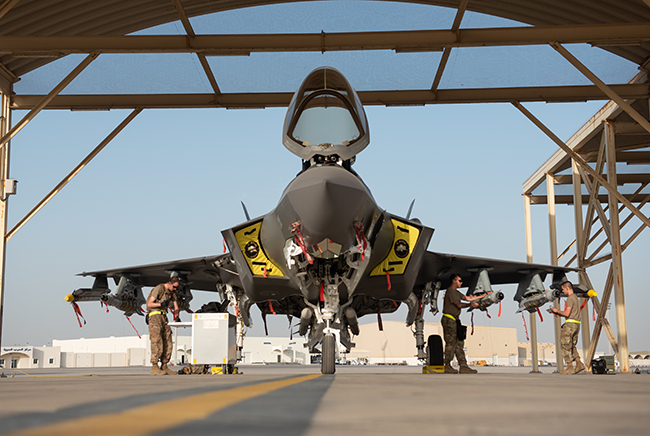
A three-man weapons load team from the 380th Expeditionary Maintenance Group, loads an F-35A Lightning II with a full external loadout at Al Dhafra AB, United Arab Emirates, in May 2019. Air Force photo by SSgt. Chris Thornbury.
The Pentagon is sending more intelligence, surveillance, and reconnaissance aircraft and another fighter squadron to the Middle East as part of a deployment of 1,500 personnel to “improve our force protection and safeguard US forces” from Iranian threats, Acting Defense Secretary Patrick Shanahan announced May 24.
The ISR and fighter aircraft, which were not identified, will provide “additional deterrence and depth to our aviation response options,” Shanahan said in a statement. Additionally, the military will deploy a Patriot missile defense battalion and an engineer element “to provide force protection improvements.” The fighter squadron will be in addition to USAF F-35s and F-15s already in the region.
“The additional deployment to the US Central Command area of responsibility is a prudent defensive measure and intended to reduce the possibility of future hostilities,” Shanahan said.
President Donald Trump, in brief remarks outside the White House, said the additional forces will be “very good in the Middle East,” though “I certainly don’t think [Iran] wants a fight with us.”
Earlier this month, the Air Force deployed four B-52s as a Bomber Task Force to Al Udeid AB, Qatar, in response to reported threats from Iran to US forces and interests, Pentagon and White House officials said. Additionally, the military deployed the USS Abraham Lincoln Carrier Strike Group and other warships to the region. B-52s have since been photographed flying deterrence missions in the area, alongside USAF F-35s and Qatari Mirage 2000s, including in the Persian Gulf.
One day before the announcement, Shanahan told reporters that US Central Command briefed military leaders on the threat, which was then related to the White House. At the time, he denied a larger deployment, saying, “What we’re focused on right now is: Do we have the right force protection in the Middle East?”